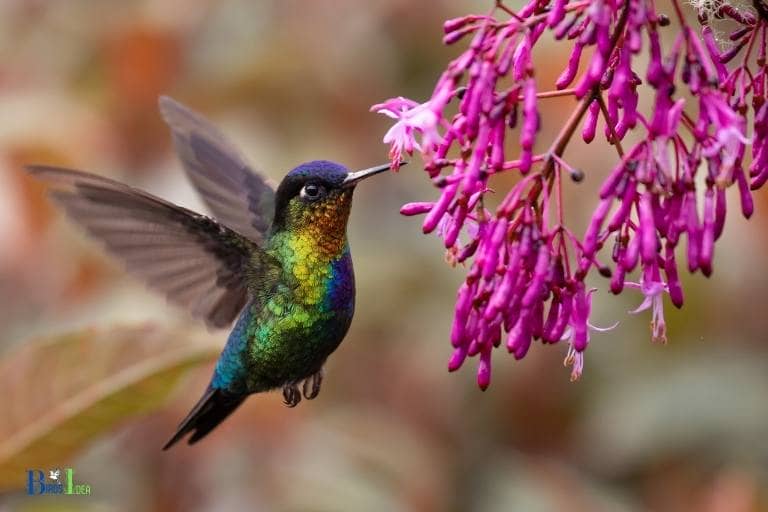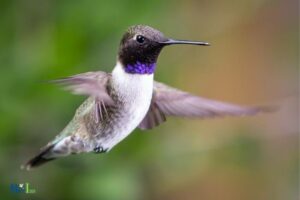What Makes a Hummingbird Hum: Rapid Movement!
The humming sound in hummingbirds is created by the rapid movement of their wings during flight.
Hummingbirds are known for their unique ability to hover and fly in multiple directions with precision. The hum that these birds are famous for is actually the result of their incredibly fast wing beats.
As they move their wings in a figure-eight pattern, they create a humming sound that can be easily recognized.
Hummingbirds are fascinating creatures, as they possess many unique characteristics, such as their high metabolism, ability to fly backwards and upside down, and their incredible speed.
However, it is the humming sound produced by their rapid wing movement that makes them truly stand out in the world of birds. This sound not only adds to their allure but also serves as a recognizable indicator of a hummingbird’s presence.
5 Factors of a Hummingbirds Hum
| Factor | Explanation |
| Rapid Wing Movement | Hummingbirds can flap their wings up to 80 times per second, creating the humming sound. |
| Wing Shape | The unique design of their wings allows them to move in a figure-8 pattern, contributing to the hum. |
| Airflow | As their wings move rapidly, the air vibrates and creates a humming sound. |
| Small Size | The small size of hummingbirds allows them to move quickly and create the distinctive hum. |
| High Metabolism | Their high metabolism assists in maintaining rapid wing movements, leading to the humming sound. |
Key Takeaway

Five Facts About: Why Hummingbirds Hum
Hummingbirds: The Ultimate Flying Machines
Hummingbirds are tiny, colorful birds that have fascinated people for centuries with their unique flying abilities. They are small but mighty birds that can hover in mid-air, fly backward, and change direction effortlessly.
Let’s explore what makes them the ultimate flying machines through their flight abilities, hovering adaptations, and wing structure and movements.
Description Of Hummingbird Flight Abilities And Specialization
Hummingbirds have evolved to have specialized flight abilities that allow them to fly at high speeds and accelerate rapidly in different directions.
Here are some of their unique flight abilities:
- Hovering: Hummingbirds can hover in mid-air, allowing them to feed on nectar from flowers and feeders.
- Aggressive flight: Hummingbirds have an aggressive nature when it comes to defending their territory, food, and mates.
- Directional control: They can change direction quickly, flying up, down, and sideways with ease. This allows them to navigate through dense foliage and avoid obstacles in their environment.
Explanation Of Hummingbird Adaptations For Hovering
Hovering is a unique ability of hummingbirds that enables them to suck nectar out of flowers without landing. To hover in mid-air, hummingbirds have several adaptations that allow them to stay suspended and maintain stability.
Here are some of their adaptations:
- Wing rotation: Hummingbirds rotate their wings in a figure-eight pattern, allowing them to create lift on both the upstroke and the downstroke.
- Muscle specialization: Hummingbirds have specialized muscles that enable them to maintain stability and hover for extended periods.
- Feeding adaptations: Their long, thin beak and tongue allow hummingbirds to feed on nectar with precision and accuracy. They can also drink nectar by using their tongue like a straw, allowing them to reach deep into flowers for the sweet nectar.
Discussion Of Hummingbird Wing Structure And Movements
Hummingbirds have unique wing structures that allow them to fly with agility, maneuverability, and speed. Their wings are short, stiff, and highly mobile, allowing them to flap their wings at high speeds.
Here are some of their wing structures and movements:
- Flexibility: Hummingbird wings are highly flexible, allowing them to rotate at the shoulder and elbow joints.
- High flapping rate: Hummingbirds can flap their wings at a rate of up to 80 beats per second. This high flapping rate allows them to generate lift and hover in mid-air without expending too much energy.
- Wing movement patterns: During hovering, their wings move in a figure-eight pattern, similar to the motion of a small helicopter rotor. During forward flight, they can rotate their wings to create a positive angle of attack, producing lift and moving forward.
Hummingbirds are incredible birds that have evolved unique flight abilities, adaptations for hovering, and specialized wing structures and movements that make them the ultimate flying machines.
They are agile, fast, and maneuverable, allowing them to thrive in their environment and mesmerize us with their unique talents.
The Secrets Of The Hummingbird Metabolism
Known for their magical, hovering ability, hummingbirds are one of the most fascinating creatures on this planet. While these feisty birds may seem delicate and tiny, their metabolisms are anything but.
In fact, their metabolism is the fastest among all vertebrates, which allows them to stay active and energetic throughout the day.
Let’s dive deeper into the hummingbird metabolism and uncover the secrets behind their high energy.
Overview Of The Hummingbird Diet
Hummingbirds have specialized diets that primarily consist of flower nectar and insects. They have long bills and tongues that are specially designed to reach the nectar deep inside flowers.
Hummingbirds can also eat small insects, such as fruit flies, which provide them with the necessary protein and minerals they need for survival.
Discussion Of Hummingbird Digestion And Metabolism
Hummingbirds have a unique digestion system. It consists of a two-chambered stomach, which allows them to break down their food quickly and efficiently.
The first chamber is where enzymes begin to break down the nectar, while the second chamber takes care of the protein-rich insects.
Hummingbirds have the highest metabolism of all birds, which is essential for their hovering ability.
In fact, they need to consume more than their body weight in nectar and insects every day just to have the energy to fly and move around.
Explanation Of The Hummingbird’S Need For High Energy
Hummingbirds are active throughout the day, and their high metabolism is critical to their survival. They need to maintain a high body temperature, which requires a lot of energy.
Their heart rate can go up to 1,200 beats per minute, which is crucial for hovering and flying at high speeds.
Additionally, male hummingbirds have larger hearts than females, which allows them to produce more energy and win over their mates during mating season.
Understanding the hummingbird metabolism gives us insight into how these incredible creatures can maintain such high energy levels.
Their specialized diet and digestion system allow hummingbirds to consume enough food to keep up with their demanding lifestyle. So next time you see a hummingbird, take a moment to appreciate the science behind their ability to hum and hover.
Anatomy Of A Hummingbird
Overview Of Hummingbird Size And Features
Hummingbirds are tiny but strong flying creatures, known for their ability to hover in mid-air, fly forwards, backwards, and even upside-down. They are about 3-5 inches long and weigh between 2-20 grams.
Here are some of their essential features:
- They have a small body with a wingspan of 3-8 inches.
- Their wings can beat up to 80 times per second, creating a distinct humming sound.
- Their feathers are iridescent, which means that they change color depending on the angle of light.
- They have a long, thin beak that enables them to feed on nectar from flowers.
- They have a high metabolism rate and need to consume twice their body weight in nectar each day to survive.
Discussion Of The Hummingbird Skeleton And Muscles
The hummingbird’s skeletal system and muscles enable them to perform incredible flight maneuvers, which are not possible with any other birds.
- They have a long, straight keel bone which provides extra support to their chest muscles and allows them to produce powerful wing beats.
- Their wing bones are small and lightweight, enabling them to flap them at high speed. They have a u-shaped notch at the end of their humerus, which provides additional support to their flight muscles.
- Their pectoral muscles, which are the largest muscles in their body, drive their wings up and down at an impressive speed.
- Their specialized shoulder joint is flexible, allowing them to rotate their wings in a full circle, which is required for their hovering ability.
Explanation Of The Unique Hummingbird Shape And Structure
Hummingbirds have unique shape and structure, which makes them stand out from all other bird species.
- Their streamlined body and small size reduce air resistance and enable them to move rapidly.
- Their short legs and tiny feet prevent them from walking on the ground but aid them in perching on thin branches and catching insects in mid-air.
- Their long beaks and tongues allow them to reach deep inside the flowers to extract nectar and insects.
- Their large brains are responsible for their excellent memory and navigation skills, which aid them in finding the best flower patches.
Hummingbirds are fascinating creatures with unique anatomy features that enable them to perform incredible flight maneuvers. Their small size and specialized organs make them exceptional and an important part of the ecosystem.
Hummingbird Migration
Overview Of Hummingbird Migration Patterns
Every year, hummingbirds embark on an incredible migration journey that takes them from their breeding grounds in north america to their wintering grounds in central and south america.
Here are some key points about hummingbird migration patterns:
- Hummingbirds typically travel alone rather than in flocks.
- Their migration route varies from species to species, with some birds traveling up to 3,000 miles.
- Most hummingbirds migrate at night to conserve energy and avoid predators.
- The timing of migration varies depending on the species and the region, but it generally occurs in the fall and spring.
Discussion Of The Hummingbird’S Survival Strategies
The journey south is a challenging one for hummingbirds. They must navigate unfamiliar terrain, avoid predators, and find food along the way.
To survive, they rely on a number of strategies:
- Building up fat reserves before migration
- Flying at high altitudes to conserve energy
- Slowing their metabolic rate to conserve energy
- Being able to go into torpor, a state of reduced activity, during periods of food scarcity
- Having excellent spatial memory to navigate their migratory route
Explanation Of The Role Of Environmental Factors In Hummingbird Migration
Environmental factors play a significant role in hummingbird migration patterns.
Here are some key points to consider:
- Hummingbirds are sensitive to changes in temperature and day length, which triggers their migratory movements.
- Changing weather patterns can alter the availability of food sources, which can impact hummingbird migration routes.
- Migration is also affected by the condition of breeding grounds and wintering grounds, which may dictate how far birds travel and where they stop along the way.
Hummingbirds undertake a remarkable journey every year to survive and thrive in different regions.
Their skillful navigation, energy conservation, and ability to adapt to environmental changes have enabled them to become one of the world’s most fascinating and beloved bird species.
FAQ For What Makes A Hummingbird Hum
How Fast Can A Hummingbird Fly?
What Makes Hummingbirds Fly Backward?
How Many Times Does A Hummingbird Flap Its Wings Per Second?
What Do Hummingbirds Eat And How Often Do They Need To Eat?
How Long Do Hummingbirds Live?
Conclusion
As we have learned, hummingbirds are fascinating creatures that possess various interesting traits. They have unique abilities such as their high-speed wing flaps, hovering skills, and their capability to fly upside down.
These birds are also known for their vivid coloring and their special diet that mainly consists of nectar.
By understanding these characteristics of hummingbirds, we can appreciate their vital role in the ecosystem and do our part in preserving their habitats.
Aiding in the conservation of these creatures allows us to continue learning and being amazed by their incredible abilities.
As a result, we can continue to enjoy the beauty and awe-inspiring nature that hummingbirds provide. So, let us take care of these tiny birds and ensure that they continue to hum their way through life.






